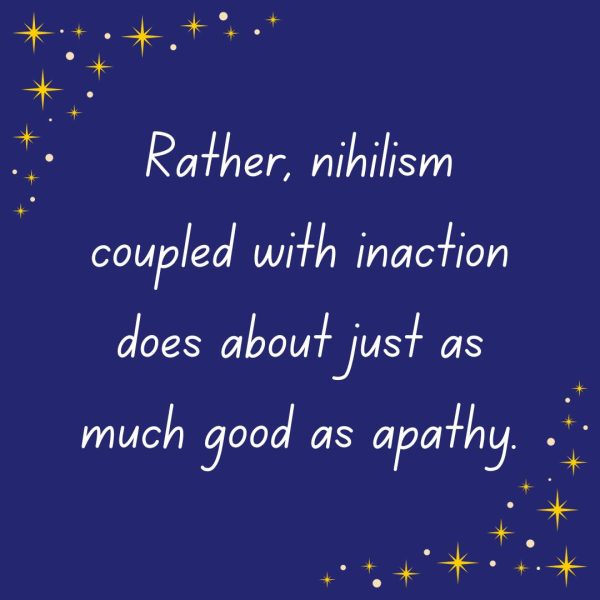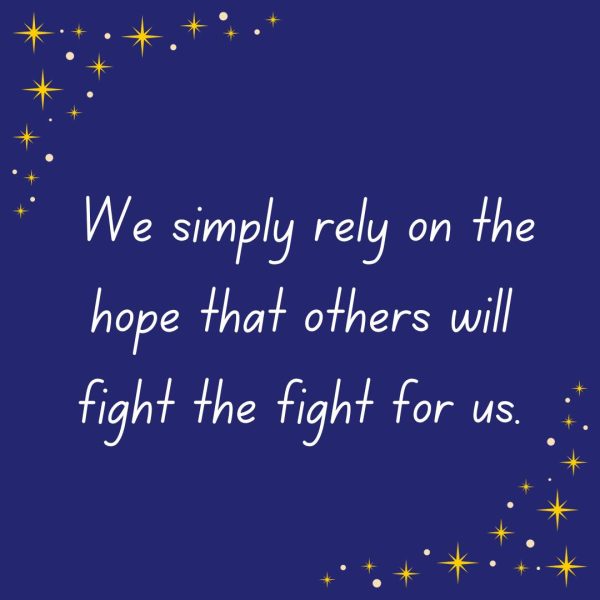Hope is necessary
Search up climate change on Google, and the immediate results almost always yield negativity: articles about the detrimental effects on health, facts about how we are not on target to meet the Paris Agreement and news that we’re on track to reach temperatures too hot for human survival jump out, inciting an immediate association of climate change with disaster. It can feel almost as though there is nothing we can do and the natural reaction is to curl up into a ball of pure panic, hopeless.
But this isn’t true.
Across the nation, climate change is being taken more seriously. The benefits of clean energy are receiving more attention, colleges and universities are ramping up their research to find solutions and electronic vehicle sales have tripled in the past three years. We have things to hope for, and we should be focusing on the things that are beneficial to us to continue the positive streak.

Climate change persistently offers problems and not solutions. However, blind panic and fear don’t serve to alleviate the stress that climate change can cause. Rather, nihilism coupled with inaction does about just as much good as apathy. While blind hope without action won’t incite concrete change, giving up hope will result in even worse conditions than we’re beginning to see now. For example, we’re currently seeing rising rates of climate anxiety because people are getting worried about the future of our planet while continuing to be bombarded with news that’s overwhelmingly negative.
Giving up hope will result in an exacerbation of this anxiety, especially among young people. These are among those the most capable of leading the future of climate change awareness —, the ones who will inherit this future and therefore should be motivated to improve it. At MVHS alone, 72.4% of students are involved in non-profit organizations, 9.7% of which are climate change nonprofits. This percentage represents students who still hold on to hope that they can make a difference if they take action, and hence strive to create the difference themselves.
It’s true that merely hoping that things will get better doesn’t do anything, and too much of just hope can cloud our vision of reality, but take away this hope and we’re left with pessimism that can transform into indifference. So after you read this, take a deep breath, appreciate the environment you’re able to enjoy in the present moment, and let hope inspire you, along with the rest of us, to take action and bring us toward something real for the sake of climate change.
Hope is not enough
According to the 2021 S&P Global Corporate Climate Assessment, there’s been an increase in the number of big corporations announcing ambitious emissions targets with long-term goals. Around the world, large companies have pledged to reduce greenhouse gas emissions “as close to zero as possible.”
These announcements have garnered a good deal of media attention and provide the appearance that as a society, we are taking enough action to address climate change. Across the nation, we’ve seen universities and cities set carbon neutrality targets as other forms of progress are underway. And in our own city, we’ve seen the city of Cupertino set a carbon neutrality goal for 2040. There’s no doubt that we’re making some progress in fighting climate change, whether locally or nationally. Yet when we hear about these big goals and celebrate our small wins, we become content in settling for the little progress we’ve made and we forget to actively advocate for more progressive goals. We simply rely on the hope that others will fight the fight for us, and we hope that these companies and world leaders will stick to their promises.
 We cannot afford to become complacent in the fight against climate change. Data collected in the 2021 S&P Global CSA show that most of the companies who pledged to reduce their emotions haven’t even set preliminary emission reduction targets. Additionally, the 27th Conference of the Parties to the United Nations Framework Convention on Climate Change (COP27) agreement failed to go beyond a previous promise from 2021 to “phase down unabated coal power,” and there have also been no new climate targets set, threatening the goal established seven years ago of limiting global temperature rise to 1.5°C.
We cannot afford to become complacent in the fight against climate change. Data collected in the 2021 S&P Global CSA show that most of the companies who pledged to reduce their emotions haven’t even set preliminary emission reduction targets. Additionally, the 27th Conference of the Parties to the United Nations Framework Convention on Climate Change (COP27) agreement failed to go beyond a previous promise from 2021 to “phase down unabated coal power,” and there have also been no new climate targets set, threatening the goal established seven years ago of limiting global temperature rise to 1.5°C.
Here’s the reality: hope is not enough. We can no longer continue to rely on hope as our only means of effecting change; instead, we need to instill a sense of urgency to fuel tangible action. In an ideal world, everyone would be inspired to fight against one of the largest threats to the next generation. Yet, as most of the world sits silently by, supporting the climate movement with “passive hope” but no real action, it’s clear that we need more than hope to secure the guarantee of a sustainable future.
Supporters of utilizing hope to inspire change say that hope drives action. Without hope, people may succumb to “climate doomerism,” the idea that society is too far past the point of being able to solve climate change or its effects like overpopulation and pollution. Thus, we must strike a careful balance between making sure people know the severity of the climate change crisis and not being so overwhelmed they feel too pessimistic to try taking action. Ultimately, it’s crucial to understand that simply hoping for a better future won’t lead to action. Instead, we need to realize that taking action is what gives us a glimmer of hope for the future.
We can start creating this change in mindset in our local community by setting tangible steps toward fighting the climate crisis. We can advocate for measurable goals to those with the power to create legislative change, such as the school board or city council, and hold them accountable for reaching those goals. For example, we can advocate to the Cupertino Union School District to install solar panels or ask the Fremont Union High School District to show how it will improve recycling at all school sites. We can educate ourselves and our community on staying updated with recent climate progress both locally and nationally.
Let’s look beyond hope that others are taking care of it and engage in policy action. Learn to use hope not as a motivator, but as a goal to work for a future in which we can afford to only hope.











